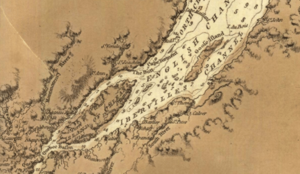Battle of Saint-Pierre facts for kids
Quick facts for kids Battle of Saint-Pierre |
|||||||
|---|---|---|---|---|---|---|---|
| Part of the American Revolutionary War | |||||||
 Detail from a 1780 map. Saint-Pierre, labelled St. Peter, is on the South River. |
|||||||
|
|||||||
| Belligerents | |||||||
| Canadian sympathizers |
|||||||
| Commanders and leaders | |||||||
| John Dubois Clément Gosselin |
Michel Blais Ignace Aubert de Gaspé Seigneur Couillard |
||||||
| Strength | |||||||
| 150 Canadian militia 80 Americans |
46 Canadian militia | ||||||
| Casualties and losses | |||||||
| 6 killed unknown wounded |
3–6 killed 10 wounded 21–38 prisoners |
||||||
The Battle of Saint-Pierre was a small fight that happened on March 25, 1776. It took place near the village of Saint-Pierre in Quebec, south of Quebec City. This battle was part of the American Revolutionary War.
It happened while the American Continental Army was trying to take Quebec City. What's interesting is that most of the fighters on both sides were Canadian militia. Some of these Canadians even came from the same towns! In the end, the American-supporting forces won. They defeated the British-supporting forces, killing at least 3 and capturing more than 30.
Contents
Why the Battle Happened
Early in the American Revolutionary War, the American leaders, called the Second Continental Congress, wanted the people of Quebec to join their fight for independence. They sent letters and then even invaded Quebec. Their goal was to remove the British government led by General Guy Carleton.
The American invasion reached its peak on December 31, 1775. The Continental Army, led by General Richard Montgomery, was defeated outside Quebec City. General Montgomery was killed, and over 400 American soldiers were captured.
After this defeat, the remaining American soldiers, now led by General Benedict Arnold, surrounded Quebec City. During this time, they tried to get French-speaking Canadians to support their cause. Meanwhile, General Carleton and the British worked to get Canadians to support the British side. These Canadians who supported the British were called Loyalists.
British Supporters Gather
On the morning of March 14, 1776, a Canadian miller named Jean-Baptiste Chasson crossed the Saint Lawrence River. He reached Quebec City and told General Carleton that the Americans were building a gun battery at Pointe-Lévis. This battery was across the river from the city and could control the harbor. Chasson also said that people south of the city were ready to fight against the Americans.
General Carleton gave Chasson messages to deliver to Louis Liénard de Beaujeu. Beaujeu was a seigneur (a type of landowner and lord in New France) from Isle-aux-Grues (Crane Island). He had military experience from the French and Indian War. Carleton's messages included secret letters from General Arnold about the tough conditions for the Americans. They also offered forgiveness to anyone who had supported the Americans but now wanted to help the British.
Beaujeu had been asked before to gather a militia (a group of citizen soldiers) to help the British. He started gathering a force to attack the unfinished battery at Pointe-Lévis. By March 23, he had over 100 men. On the night of March 24, another 70 men joined them. A smaller group of 46 men went ahead to Saint-Pierre. This group was led by Couillard and Gaspé. They set up their base at the house of Michel Blais, a Loyalist and former local militia leader.
Americans Get a Warning
Habitants (French-Canadian farmers) from Beaumont who supported the Americans found out about the British recruitment. They told the American commander at Pointe-Lévis.
In response, General Arnold sent 80 American soldiers under John Dubois to handle the situation. Pierre Ayotte and Clément Gosselin were recruiters for the American side. They gathered about 150 Canadian men to join the Americans. These forces then headed along the southern shore to investigate the reports. Some of these new Canadian recruits were from the same villages where Beaujeu had recruited his men. A small group of militia from Beaumont went to Saint-Michel. There, they arrested Chasson, who was planning to return to Quebec City.
The Fight Begins
The British-supporting advance guard at Saint-Pierre was surprised when the American-supporting forces arrived. They quickly barricaded themselves inside Michel Blais's house. Dubois's men attacked the house using muskets and cannons.
A few of the British-supporting soldiers managed to escape. However, most of them surrendered. Three were killed in the fight. Their priest, Charles-François Bailly de Messein, was also wounded. It is said that because both sides recruited from the same areas, some families had members fighting against each other in this battle.
What Happened Next
After his plans were discovered, Beaujeu broke up his militia and went into hiding on Île-aux-Grues. Dubois confirmed that the British had approved the Loyalist actions. Because of this, some of the captured soldiers were released. They promised not to fight again. The remaining 21 prisoners were sent to the American camp outside Quebec City.
This small battle did not really change how the local people felt about the Americans. Relations were already getting worse as the siege of Quebec City continued. This was partly because the Americans often paid for supplies with paper money or promises to pay later. The local people thought this money was not worth much.
See also


